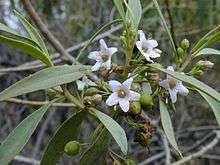Myoporum
| Myoporum | |
|---|---|
 | |
| Naio (Myoporum sandwicense) | |
| Scientific classification | |
| Kingdom: | Plantae |
| (unranked): | Angiosperms |
| (unranked): | Eudicots |
| (unranked): | Asterids |
| Order: | Lamiales |
| Family: | Scrophulariaceae |
| Tribe: | Myoporeae |
| Genus: | Myoporum Banks & Sol. ex G.Forst.[1] |
| Species | |
|
See text. | |
Myoporum is a genus of flowering plants in the figwort family, Scrophulariaceae (formerly placed in Myoporaceae). There are 30 species in the genus, most of which are endemic to Australia although others are endemic to Pacific Islands, including New Zealand, and one is endemic to two Indian Ocean islands. They are shrubs or small trees with leaves that are arranged alternately and have white, occasionally pink flowers and a fruit that is a drupe.
Description
Plants in this genus are shrubs or small trees, mostly glabrous with simple leaves that are arranged alternately and often lack a petiole (although the leaves often taper towards the base). The flowers are adapted for pollination by insects and have white, (sometimes pinkish) petals and usually 4 stamens. The fruit is a drupe with its central seed surrounded by a hard endocarp and usually succulent mesocarp.[2][3]
Taxonomy and naming
The genus Myoporum was first formally described in 1786 by Georg Forster, although he acknowledged Daniel Solander as the author.[4][5] The name Myoporum is derived from the Ancient Greek myo meaning "to close" or "to be shut" and poros meaning "pore", referring to the ability of (some) plants in this genus to exist in dry areas,[6] or possibly to the appearance of the glands on the leaves.[7]
Distribution
There are 30 species in the genus, which is spread from Mauritius, across Australia to the Pacific Islands. 18 species are endemic to Australia.
Use in horticulture
M. parvifolium, M. floribundum and M. bateae are often cultivated as ornamentals, hedges or windbreaks. M. insulare, M. montanum, M. acuminatum and sometimes M. parvifolium are often used as rootstock for Eremophila species, especially those that are difficult to grow from cuttings or that are to be grown in heavier soils. Some, including M. insulare and M. laetum are known to be poisonous to stock.[3][8]
Species list
The following is a list of the species of Myoporum as described by Robert Chinnock.[2]
- Myoporum acuminatum R.Br. – Pointed boobialla (Australia)
- Myoporum bateae F.Muell. – (New South Wales)
- Myoporum betcheanum L.S.Sm. – Mountain boobialla (New South Wales, Queensland)
- Myoporum boninense Koidz. (New South Wales, Queensland, Bonin to Mariana Islands)
- Myoporum brevipes Benth. – Pale myoporum (mainly South Australia)
- Myoporum caprarioides Benth. – Slender myoporum (Western Australia)
- Myoporum cordifolium (F.Muell.) Druce – Jerramungup myoporum (Western Australia)
- Myoporum crassifolium G.Forst. (New Caledonia, Vanuatu)
- Myoporum degeneri (G.L.Webster) O.Deg. & I.Deg. – (Hawaii)
- Myoporum floribundum A.Cunn. ex Benth. – Weeping boobialla (New South Wales, (Victoria)
- Myoporum insulare R.Br. – Boobialla, Blueberry tree (Australia)
- Myoporum laetum G.Forst. – Ngaio (New Zealand)
- Myoporum mauritianum A.DC. – (Mauritius and Rodrigues)
- Myoporum montanum R.Br. – Native myrtle (Australia)
- Myoporum obscurum Endl. Bastard ironwood, Popwood (Norfolk Island)
- Myoporum oppositifolium R.Br. Twin-leaf myoporum (Australia)
- Myoporum parvifolium R.Br. – Creeping boobialla (Australia)
- Myoporum petiolatum R.J.Chinnock – Sticky boobialla (Australia)
- Myoporum platycarpum R.Br. Sugarwood (Australia)
- Myoporum rapense F.Br. (French Polynesia)
- Myoporum rimatarense F.Br. (French Polynesia)
- Myoporum sandwicense A.Gray – Naio (Hawaii, Mangaia)
- Myoporum stellatum (G.L.Webster) O.Deg. & I.Deg. – (Hawaii)
- Myoporum stokesii F.Br. (French Polynesia)
- Myoporum tenuifolium G.Forst. – (New Caledonia and Loyalty Islands)
- Myoporum tetrandrum (Labill.) Domin Boobialla (Australia)
- Myoporum turbinatum R.J.Chinnock Salt myoporum (Australia)
- Myoporum velutinum R.J.Chinnock (Western Australia)
- Myoporum viscosum R.Br. – Sticky boobialla (South Australia)
- Myoporum wilderi Skottsb. (Cook Islands)
Formerly placed here
- Eremophila debilis (Andrews) Chinnock (as M. debile (Andrews) R.Br.)
- Eremophila deserti (A.Cunn. ex Benth.) Chinnock (as M. deserti A.Cunn. ex Benth.)
References
| Wikimedia Commons has media related to Myoporum. |
| Wikispecies has information related to: Myoporum |
- ↑ "Myoporum Sol. ex G. Forst.". Germplasm Resources Information Network. United States Department of Agriculture. 2006-04-20. Retrieved 2011-02-06.
- 1 2 Chinnock, R.J. (2007). Eremophila and allied genera : a monograph of the plant family Myoporaceae (1st ed.). Dural, NSW: Rosenberg. p. 95. ISBN 9781877058165. Retrieved 31 August 2015.
- 1 2 "Plantnet - Royal Botanic Gardens (Sydney)". National Herbarium of New South Wales. Retrieved 10 January 2015.
- ↑ "Myoporum". APNI. Retrieved 31 August 2015.
- ↑ Forster, Georg (1786). Florulae Insularum Australium Prodromus. Göttingen. p. 44. Retrieved 31 August 2015.
- ↑ Crisp, Michael (1986). "Myoporum bateae". Australian National Botanic Garden. Retrieved 10 January 2015.
- ↑ "Australian Native Plant Society (Australia)". Australian Native Plant Society (Australia). October 2013. Retrieved 10 January 2015.
- ↑ Boschen, Norma; Goods, Maree; Wait, Russell (2008). Australia's eremophilas : changing gardens for a changing climate. Melbourne: Bloomings Books. pp. 23–24. ISBN 9781876473655.